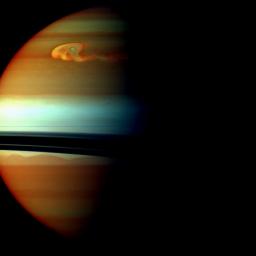
|
Storm Head in False Color
- Click the image above for a larger view
- Full-Res JPEG (768 x 768) (21.2 kB)
- Full-Res TIFF (768 x 768) (1.8 MB)
Caption:
The head of Saturn's huge northern storm is well established in this view captured early in the storm's development by NASA's Cassini spacecraft in late 2010.
Saturn's atmosphere and its rings are shown here in a false-color composite made from three images taken in near-infrared light through filters that are sensitive to varying degrees of methane absorption. Red and orange colors in this view indicate clouds that are deep in the atmosphere. Yellow and green colors, most noticeable near the top of the view, indicate intermediate clouds. White and blue indicate high clouds and haze. The rings appear as a thin horizontal line of bright blue because they are outside of the atmosphere and not affected by methane absorption.
For a nearly true-color version of this view, see PIA12824 .
See PIA14905 to learn more about this storm and watch its development over several months. Earlier in the Cassini mission, the spacecraft chronicled a smaller storm in the southern hemisphere called the "Dragon Storm." See PIA06197 to learn more about that storm and to see a similar, false-color view.
This view looks toward the southern, unilluminated side of the rings from just below the ring plane.
The images were taken with the Cassini spacecraft wide-angle camera using a combination of spectral filters sensitive to wavelengths of near-infrared light. The image filtered at 890 nanometers is projected as blue. The image filtered at 728 nanometers is projected as green, and the image filtered at 752 nanometers is projected as red.
The images were taken on Dec. 24, 2010. The view was obtained at a distance of approximately 1.2 million miles (1.9 million kilometers) from Saturn and at a sun-Saturn-spacecraft, or phase, angle of 71 degrees. Image scale is about 89 miles (143 kilometers) per pixel.
Background Info:
The Cassini-Huygens mission is a cooperative project of NASA, the European Space Agency and the Italian Space Agency. NASA's Jet Propulsion Laboratory, a division of the California Institute of Technology in Pasadena manages the mission for NASA's Science Mission Directorate, Washington. The Cassini orbiter and its two onboard cameras were designed, developed and assembled at JPL. The imaging team is based at the Space Science Institute, Boulder, Colo.
For more information about the Cassini-Huygens mission, visit http://saturn.jpl.nasa.gov and the Cassini imaging team home page, http://ciclops.org .
Cataloging Keywords:
| Name | Value | Additional Values |
|---|---|---|
| Target | Saturn | |
| System | Saturn | |
| Target Type | Planet | |
| Mission | Cassini-Huygens | |
| Instrument Host | Cassini Orbiter | |
| Host Type | Orbiter | |
| Instrument | Imaging Science Subsystem (ISS) | |
| Detector | Wide Angle Camera | |
| Extra Keywords | Atmosphere, Color, Haze, Infrared, Methane, Storm, Visual | |
| Acquisition Date | ||
| Release Date | 2011-11-17 | |
| Date in Caption | 2010-12-24 | |
| Image Credit | NASA/JPL-Caltech/Space Science Institute | |
| Source | photojournal.jpl.nasa.gov/catalog/PIA12828 | |
| Identifier | PIA12828 | |
